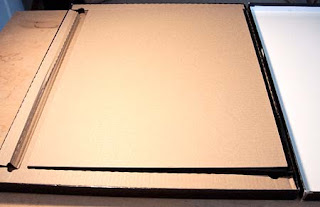Thinking the problem may be a failing USB port on his computer's motherboard, Dean switch to a different port. I haven't heard whether he's experienced the problem since.
[Update 19 December: The problem hasn't recurred since Dean switched to a different USB port.]
[Update 19 December: The problem hasn't recurred since Dean switched to a different USB port.]
Yesterday, it happened to me, which probably eliminates the USB port as the likely cause.
I had some unusual circumstances leading up to the problem. My 7900 has been powered-up for most of a year. When not in use it goes into standby mode. Last week, however, the local power utility scheduled an outage that was to last up to two hours. I powered down the printer and switched off its UPS. As I didn't expect to be printing soon, I left the machine off after the power to the mains was restored.
Yesterday I received, via email, a print job. The client needed it right away, and I had the time to accommodate him. This required a switch from PK to MK. I powered up the printer and watched as it went through its start-up routine. I printed a nozzle check and found LC almost completely gone. I did the black ink swap. Going in the PK to MK direction, the printer does not force a cleaning as it does when switching from MK to PK. When the swap completed, I initiated a cleaning of the LC/VLM pair. That successfully cleared the LC nozzles; no other nozzle issues were found.
I set up the print job, which was for ten of the same print. I set the quantity to five, and then moved to the printer to start feeding sheets. The first print started normally, but when about one-third complete, it ejected from the printer. The LCD showed "Resetting, please wait..." Uh-oh. This is the problem Dean reported.
I removed the sheet of paper, and then at the computer canceled the job. I found no complaints or messages from the printer driver; everything looked normal. I checked the status lights on the 7900's network port and on my 16-port gigabit switch. All looked normal, no change from the way things have appeared for more than a year.
Once again I set up the print job, this time with a quantity of one, and for plain paper. I fed a sheet of plain bond and once again got the resetting error. In addition, I'd made a mistake with the layout, setting the sheet orientation incorrectly, so this test would have failed anyway.
OK, third time's a charm, right? I set up the job again, quantity of one, with the proper mat paper and the correct orientation. The print was perfect. I set up again, quantity of two, and got two perfect prints. I finished the first half of the job by printing two more copies, also without problems.
Finally, I set up again, quantity of five, and got five perfect prints.
I'm in the dark on this. No idea what failed or why. The Mac OS keeps logs of everything (perhaps Windows does, too). I found this in the CUPS (print architecture) log:
E [16/Dec/2012:16:22:01 -0700] [Job 19] Remote host did not accept data file (2).
E [16/Dec/2012:16:31:48 -0700] [Job 20] Remote host did not accept data file (2).
It corresponds to the times I saw the errors on the printer, but it's otherwise not real helpful. A quick look with Google didn't provide any help decoding the CUPS messages. More research required. I also checked the job history in the print driver. No errors are listed; it seems this is not a log in which errors would appear.
--Jay



























